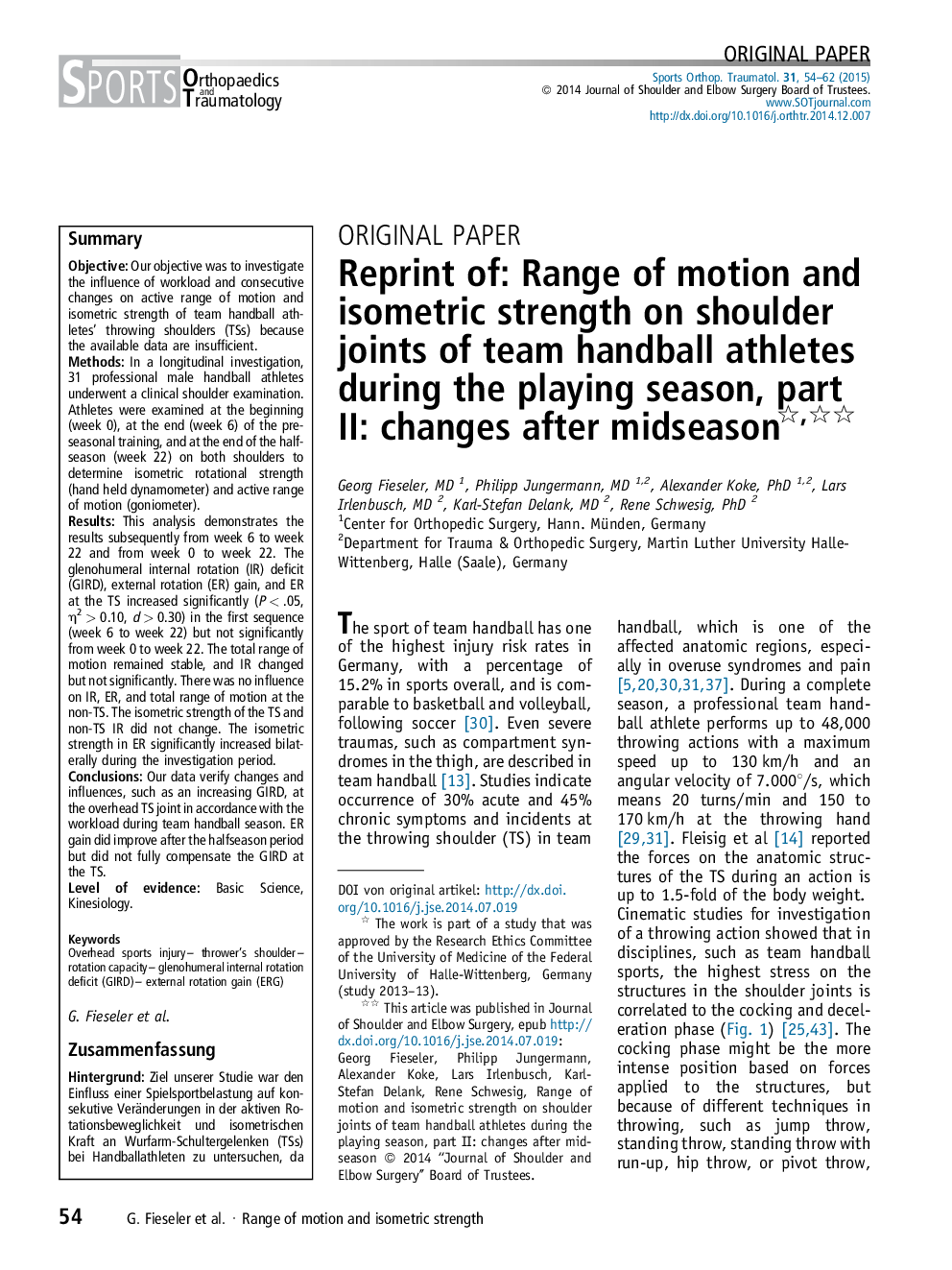| کد مقاله | کد نشریه | سال انتشار | مقاله انگلیسی | نسخه تمام متن |
|---|---|---|---|---|
| 2740244 | 1148462 | 2015 | 9 صفحه PDF | دانلود رایگان |
SummaryObjectiveOur objective was to investigate the influence of workload and consecutive changes on active range of motion and isometric strength of team handball athletes’ throwing shoulders (TSs) because the available data are insufficient.MethodsIn a longitudinal investigation, 31 professional male handball athletes underwent a clinical shoulder examination. Athletes were examined at the beginning (week 0), at the end (week 6) of the preseasonal training, and at the end of the half-season (week 22) on both shoulders to determine isometric rotational strength (hand held dynamometer) and active range of motion (goniometer).ResultsThis analysis demonstrates the results subsequently from week 6 to week 22 and from week 0 to week 22. The glenohumeral internal rotation (IR) deficit (GIRD), external rotation (ER) gain, and ER at the TS increased significantly (P < .05, η2 > 0.10, d > 0.30) in the first sequence (week 6 to week 22) but not significantly from week 0 to week 22. The total range of motion remained stable, and IR changed but not significantly. There was no influence on IR, ER, and total range of motion at the non-TS. The isometric strength of the TS and non-TS IR did not change. The isometric strength in ER significantly increased bilaterally during the investigation period.ConclusionsOur data verify changes and influences, such as an increasing GIRD, at the overhead TS joint in accordance with the workload during team handball season. ER gain did improve after the halfseason period but did not fully compensate the GIRD at the TS.Level of evidenceBasic Science, Kinesiology.
ZusammenfassungHintergrundZiel unserer Studie war den Einfluss einer Spielsportbelastung auf konsekutive Veränderungen in der aktiven Rotationsbeweglichkeit und isometrischen Kraft an Wurfarm-Schultergelenken (TSs) bei Handballathleten zu untersuchen, da diesbezüglich nur wenig Literatur vorhanden ist.Material und MethodenIn einer longitudinal angelegten Studie wurden 31 professionelle männliche Handballsportler an ihren Schultergelenken klinisch untersucht. Bei den Athleten wurden zu Beginn (Woche 0) und am Ende (Woche 6) der Saisonvorbereitung sowie nach Abschluss der Hin-Serie (Woche 22) an beiden Schultergelenken (Wurfarm = Throwing (TS), Nicht Wurfarm = Non Throwing Shoulder (non-TS)) die isometrische Kraft mit einem Hand-Dynamometer sowie die aktive Rotationsbeweglichkeit mit einem Goniometer bestimmt.ErgebnisseDiese Analyse beschreibt die sequentiellen Ergebnisse von Woche 6 zu Woche 22 sowie von Woche 0 zu Woche 22. Das glenohumerale Innenrotationsdefizit (GIRD), die Außenrotations- (ER) und –erweiterung (ERG) vergrößerten sich an der TS signifikant (P <.05, h2 > 0.10, d > 0.30) in der ersten Sequenz (Woche 6 zu Woche 22), allerdings nicht signifikant von Woche 0 zu Woche 22. Die Gesamt-Rotationsbeweglichkeit (ROM) blieb stabil, die Innenrotation (IR) veränderte sich nicht signifikant. Es konnte kein Einfluss auf IR, ER und ROM an der non-TS festgestellt werden. Die isometrische Kraft an der TS und non-TS veränderte sich in der IR nicht. Die Kraft in ER steigerte sich signifikant an beiden Schultergelenken über beide Beobachtungszeiträume.SchlussfolgerungenUnsere Daten belegen den Einfluss und Veränderungen, wie die Erhöhung eines GIRD an Schultergelenken unter der Belastung einer Handballsaison. Eine ERG wird ebenfalls vergrößert nach einer halben Spielsaison, kompensiert jedoch nicht vollständig ein glenohumerales Innenrotationsdefizit (GIRD) an einer Wurfarmschulter.EvidenzebeneGrundlagenwissenschaft, Bewegungslehre.
Journal: Sports Orthopaedics and Traumatology Sport-Orthopädie - Sport-Traumatologie - Volume 31, Issue 1, March 2015, Pages 54–62
